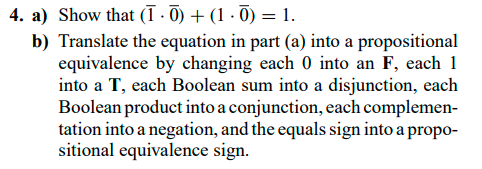4. a) Show that (T · Ō) + (1 · Ō) = 1. b) Translate the equation in part (a) into a propositional equivalence by changing each 0 into an F, each 1 into a T, each Boolean sum into a disjunction, each Boolean product into a conjunction, each complemen- tation into a negation, and the equals sign into a propo- sitional equivalence sign.
4. a) Show that (T · Ō) + (1 · Ō) = 1. b) Translate the equation in part (a) into a propositional equivalence by changing each 0 into an F, each 1 into a T, each Boolean sum into a disjunction, each Boolean product into a conjunction, each complemen- tation into a negation, and the equals sign into a propo- sitional equivalence sign.
Algebra & Trigonometry with Analytic Geometry
13th Edition
ISBN:9781133382119
Author:Swokowski
Publisher:Swokowski
Chapter3: Functions And Graphs
Section3.5: Graphs Of Functions
Problem 56E
Related questions
Topic Video
Question

Transcribed Image Text:4. a) Show that (ī · Ō) + (1 · Ō) = 1.
b) Translate the equation in part (a) into a propositional
equivalence by changing each 0 into an F, each 1
into a T, each Boolean sum into a disjunction, each
Boolean product into a conjunction, each complemen-
tation into a negation, and the equals sign into a propo-
sitional equivalence sign.
Expert Solution
This question has been solved!
Explore an expertly crafted, step-by-step solution for a thorough understanding of key concepts.
Step by step
Solved in 2 steps with 2 images

Knowledge Booster
Learn more about
Need a deep-dive on the concept behind this application? Look no further. Learn more about this topic, advanced-math and related others by exploring similar questions and additional content below.Recommended textbooks for you

Algebra & Trigonometry with Analytic Geometry
Algebra
ISBN:
9781133382119
Author:
Swokowski
Publisher:
Cengage

Elements Of Modern Algebra
Algebra
ISBN:
9781285463230
Author:
Gilbert, Linda, Jimmie
Publisher:
Cengage Learning,

Algebra & Trigonometry with Analytic Geometry
Algebra
ISBN:
9781133382119
Author:
Swokowski
Publisher:
Cengage

Elements Of Modern Algebra
Algebra
ISBN:
9781285463230
Author:
Gilbert, Linda, Jimmie
Publisher:
Cengage Learning,